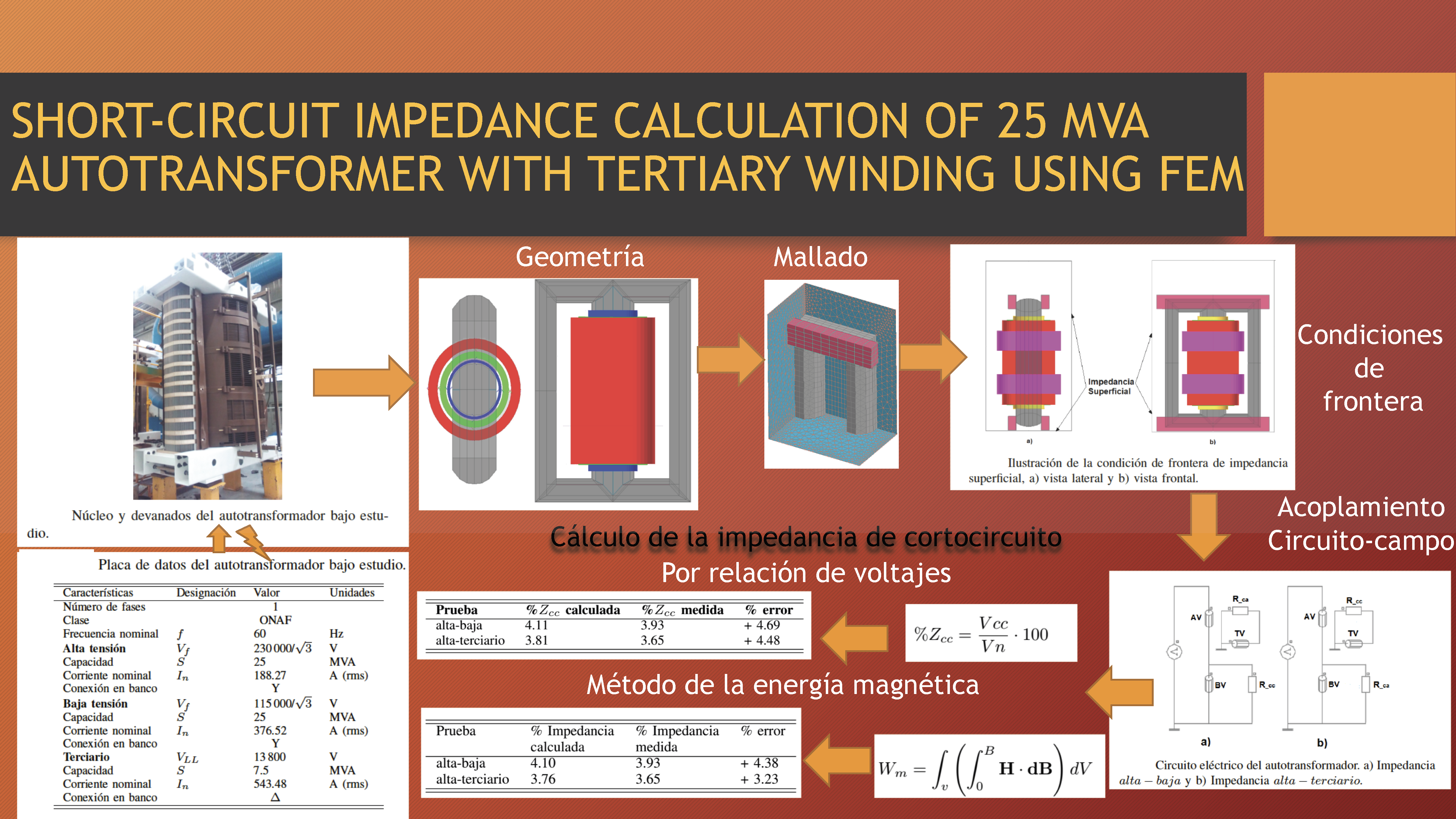Short-circuit Impedance Calculation of 25 MVA Autotransformer with Tertiary Winding using FEM
Keywords:
autotransformer, finite element method, impedance, short-circuit, tertiary windingAbstract
In this article, the percentage of short-circuit impedance is calculated using the finite element method for a single-phase power autotransformer with tertiary winding. The autotransformer specifications are: 25 MVA, 230 kV, 60 Hz, three-legged core type. A detailed 3D model where mixed formulations in terms of scalar and vector potential and circuit coupling is used. This type of study is essential to design the autotransformer and guarantee the impedance value, and so the safety and operability of electrical power systems. To calculate the percentage of short-circuit impedance the voltage relationship between the short-circuit voltage and the nominal voltage is used. In addition, the magnetic energy storage technique is presented as another alternative to calculate this parameter. The results are validated with the data from the laboratory tests obtaining differences of less than 5%.
Downloads
References
A. A. Halacsy and G. H. Von Fuchs, “Transformer invented 75 years ago,” Electrical Engineering, vol. 80, no. 6, pp. 404-407, 1961.
A. Mohd and R. Rupesh, "Transient over-voltages during switching of Korndorfer auto-transformer motor starters," CIGRE India Journal, vol. 9, no 2, pp. 7-10, 2020.
G. Ion, S. Costinas, A. Stan and F. Balasiu, "Assessment of Life Cycle of Autotransformers," 2022 International Conference on Electrical, Computer and Energy Technologies (ICECET), Prague, Czech
Republic, pp. 1-5, July 2022.
IEEE Guide for the Application of Tertiary and Stabilizing Windings in Power Transformers, C57.158-2017, IEEE Power and Energy Society, 2017.
P. Zhihua, Z. Hongfa, Y. Jintian, H. Guohua and T. Jie, “Threedimensional leakage magnetic field simulation and short-circuit impedance calculation of large yoke transformer,” International Conference on Intelligent Computing, Automation and Systems, Chongqing, China, pp. 479-482, 2021.
T. Paviˇci´c, B. Filipovi´c-Grˇci´c, D. Filipovi´c-Grˇci´c and B. Juriši´c, “Effects of autotransformer’s stabilizing winding on current-voltage conditions during unsymmetrical faults,” Electric Power Systems
Research, vol. 196, pp. 107259, 2021.
H. Wang, Y. Li, Y. Jing, and D. Zou, “Research on radial stability of autotransformer inner winding under the short-circuit condition,” International Conference on Power Electronics and Drive Systems
(PEDS), Honolulu, HI, USA, pp. 312–315, 2017.
T. Chiulan and B. Pantelimon, “A practical example of power transformer unit winding condition assessment by means of shortcircuit impedance measurement,” 2009 IEEE Bucharest PowerTech,
Bucharest, Romania, pp. 1-4, 2009.
Z. Ye et al., “A calculation method to adjust the short-circuit impedance of a transformer,” IEEE Access, vol. 8, pp. 223 848–223 858, 2020.
L. Tang and P. Zhao, “Tertiary voltage unbalance compensation for 500 kV single phase autotransformer banks,” Transmission and Distribution Conference and Exposition, Denver, CO, USA, vol. 8, pp. 1–6, 2018.
C. Seneviratne and C. Ozansoy, “Why neutral earthing resistors are ineffective for autotransformers with the delta tertiary winding,” 9th International Conference on Electrical and Electronics Engineering,
Bursa, Turkey, vol. 8, pp. 484–488, 2015.
I. V YaYakimets. "Tertiary winding voltage stabilization in autotransformers with tap change load," Electricity (in Russian), vol. 3, pp. 17-22, 1996.
I. V. Yakimets and V. G. Narovlyanskii, “Autotransformers with a voltage-stabilized tertiary winding”, Electrical Technology, vol. 1, no. 95, pp. 21-30, 1995.
C. M. Arturi, “Model of a highly saturated three-phase autotransformer with tertiary winding and five-limb core and analysis of a timevarying short-circuit transient,” European Transactions on Electrical
Power, vol. 4, no. 6, pp. 513–524, 1994.
J. D. Aspnes and S. -I. Akasofu, “Effect of Solar Induced Current on Autotransformer Tertiary Windings,” IEEE Transactions on Power Apparatus and Systems, vol. PAS-101, no. 3, pp. 635-638, March 1982.
P. A. Oakes, “Special Circuits Ror Ground Relay Current Polarization from Autotransformers Having Delta Tertiary,” in Transactions of the American Institute of Electrical Engineers. Part III: Power Apparatus
and Systems vol. 78, no. 4, pp. 1191-1194, 1959.
O. T. Farry, “Tertiary Windings in Autotransformers,” Transactions of the American Institute of Electrical Engineers. Part III: Power Apparatus and Systems, vol. 80, pp. 78-82, 1961.
X. Yu, Y. Yu, J. Xu, Y. Liu, R. Liu and X. Zhang, “Research on Leakage Flux Control and Stray Loss Calculation on Metal Structure of Ultra High Voltage Autotransformer with Large Capacity,” 2021 International Conference on Advanced Electrical Equipment and Reliable Operation (AEERO), Beijing, China, pp. 1-6, October 2021.
A. M. Sobrinño, J. R. Camacho, J. A. Malagoli and A. C. F. Mamede, “Analysis of the Maximum Inrush Current in the Optimal Design of a Single Phase Transformer,” IEEE Latin America Transactions, vol.
, no. 12, pp. 4706-4713, 2016.
J. A. Stratton, “Electromagnetic Theory,” Swedenborg Press, 2010.
Flux 11: User Guide. CAD Package for Electromagnetic and Thermal Analysis using Finite Elements. CEDRAT Design Solutions for Electrical Engineering, 2013.
D. A. Aragon-Verduzco, J. C. Olivares-Galvan, E. Campero- Littlewood, R. Ocon-Valdez, L. Teuffer-Zuñiga and S. Magdaleno- Adame, “Behavior of magnetic properties of power transformers structural steel A36 at different temperatures,” IEEE International Autumn Meeting on Power, Electronics and Computing (ROPEC), Ixtapa, Mexico, pp. 1-5, 2019.
S. V. Yuferev and N. Ida, “Surface Impedance Boundary Conditions: A Comprehensive Approach,” CRC Press, 2010.
L. J. Segerling, “Applied finite analysis,” Wiley, New York, vol. 316, 1976.
J. C. Sabonnadiere and J. L. Coulomb, “Finite element methods in CAD: electrical and magnetic fields,” Springer Science Business Media, 2012.
S. A. Holland, G. P. O’Connell and L. Haydock, “Calculating stray losses in power transformers using surface impedance with finite elements,” IEEE Transactions on Power Delivery, vol. 28, no. 2, pp.
-1358, 1992.
Standard Test Code for Liquid-Immersed Distribution, Power and Regulating Transformers, C57.12.90-2021, IEEE Power and Energy Society, 2021.


